Quba District (Azerbaijan)
Quba (Azerbaijani: Quba rayonu, Lezgian: Къуба район) is a rayon in northeastern Azerbaijan. The capital, Quba, is located on the Qudyal River at 41.37°N, 48.50°E.
Quba | |
|---|---|
| Azerbaijani: Quba rayonu | |
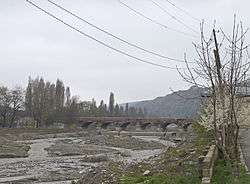 | |
.svg.png) Map of Azerbaijan showing Quba Rayon | |
| Coordinates: 41°22′12″N 48°30′00″E | |
| Country | |
| Capital | Quba |
| Area | |
| • Total | 2,610 km2 (1,010 sq mi) |
| Population (2018)[2] | |
| • Total | 170,000 |
| • Density | 65/km2 (170/sq mi) |
| Time zone | UTC+4 (AZT) |
| Postal code | 4000 |
| Telephone code | (+994) 23[3] |
| Website | www |
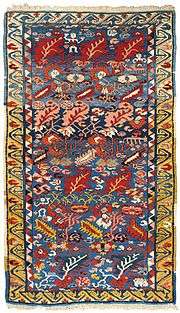
The fertile region surrounding Quba is best known for its production of apples and the city area of Quba is known for its fine carpets.
History
Quba rose to prominence in the 18th century. In 1747, Nader Shah ruler of the Persian Empire was assassinated. That same year, Hussein-Ali, the Shah's designated ruler of the region, decided to attempt to unify the Azeri khanates as an independent kingdom. One of his first moves was to relocate his capital from the less defensible Xudat in the Caspian lowlands to Quba where he built a fortress. Hussein-Ali died in 1757 and his son Fatali Khan carried on the expansion with Quba reaping the riches of its status as the capital. Some ruins from this period, such as Çirax Qala on the way to Baku, exist today.
However, upon Fatali Khan's death in 1789, the city's fortunes began to turn. In 1806, the khanate was occupied and soon absorbed by the Russian Empire. As a result, the city fell into the background of Azerbaijani history and politics.
The city is home to several historic buildings, including the Juma Mosque (Cuma Məscid or Friday Mosque), Ardabil Mosque (Ərdəbil Məscid) and old hamman (baths).
The region is home to Azerbaijan's largest community of Mountain Jews in the community of Qırmızı Qəsəbə (formerly in Russian: Krasnaya Sloboda, English: Red Town), located just across the river from Quba City.
Agriculture of Quba
Guba region has been known for its fruitful gardens since the Soviet era. According to the annual report of the Azerbaijan Statistical Committee, the apple orchards in the Guba-Khachmaz economic region covers nearly 22,000 hectares. About 14,000 hectares of these are in the Guba district.[4][5]
Apple festival
Since 2012, every year an apple festival is held in Guba. Compositions, national dances reflecting Azerbaijani custom and traditions, different types of apples, sweets and drinks prepared from apple are demonstrated at the ceremony. Various competitions are held among the gardeners at the "Apple Festival".[5]
Information on historical and architectural monuments
Ancient Guba contains at least 134 historical and archeological monuments. These include the temple of Fire-worshippers near Khynalyg village, tombs of Aghbil village dating back to the 16th century, the Mosques Sakinekhanum, Hadjy Djafar and Djuma of Guba which dates back to the 19th century, and the Gumbezli bath house.
In the district, there is a bust of the state official A.A. Bakikhanov, the statue of poet Samed Vurghun and a statue of the Soldier, dedicated to the memory of those killed in the Great Patriotic War.
Demographics
Azerbaijanis (All parts of district) - 79.22%, Tats (Southern parts) - 9.10% and Lezgians (Northwestern parts) - 5.87 % are the largest ethnic groups of Quba District. Khinalugs (1.43%) are living in the village of Khinalug.[6] Buduq(All parts of district)-65%-(Budukh)
| Ethnic
group |
27 January-3 February 1999 Census [7] | 13-22 April 2009 Census [8] | ||
|---|---|---|---|---|
| Population | % | Population | % | |
| Total | 136 845 | 100.00 | 152 452 | 100.00 |
| Azerbaijanis | 120 502 | 88.06 | 98 774 | 62.22 |
| Khinalug | 2 177 | 1.43 | ||
| Qriz | 778 | 0.51 | ||
| Tat People | 1 088 | 0.80 | 13 880 | 9,1 |
| Lezgins | 9 312 | 6.80 | 8 952 | 5.87 |
| Jews | 2 819 | 2.06 | 2 705 | 1.77 |
| Turkish people | 2 615 | 1.91 | 2 159 | 1.42 |
| Russians | 321 | 0.23 | 135 | 0.09 |
| Tatars | 85 | 0.06 | 63 | 0.04 |
| Ukrainians | 32 | 0.02 | 13 | 0.01 |
| Talysh people | 10 | |||
| Georgians | 14 | 0.01 | 5 | 0.00 |
| Armenians | 7 | 0.01 | ||
| Others | 50 | 0.04 | 801 | 0.53 |
Population
According to the Statistical Committee of the Republic, the number total of the population was 137,8 thousand in 2000. This figure increased by approximately 32.2 thousand and reached 170 thousand In 2018.[9]
| Region | 2000 | 2001 | 2002 | 2003 | 2004 | 2005 | 2006 | 2007 | 2008 | 2009 | 2010 | 2011 | 2012 | 2013 | 2014 | 2015 | 2016 | 2017 | 2018 |
|---|---|---|---|---|---|---|---|---|---|---|---|---|---|---|---|---|---|---|---|
| Guba region | 137,8 | 139,1 | 140,0 | 141,0 | 142,0 | 143,8 | 146,1 | 148,6 | 150,7 | 152,0 | 153,6 | 155,6 | 157,6 | 159,3 | 161,4 | 163,9 | 166,2 | 168,4 | 170,0 |
| urban population | 26,9 | 27,0 | 27,1 | 27,2 | 31,5 | 31,8 | 32,2 | 32,3 | 37,7 | 37,9 | 38,1 | 38,4 | 38,7 | 38,8 | 39,0 | 39,4 | 39,8 | 40,2 | 40,4 |
| rural population | 110,9 | 112,1 | 112,9 | 113,8 | 110,5 | 112,0 | 113,9 | 116,3 | 113,0 | 114,1 | 115,5 | 117,2 | 118,9 | 120,5 | 122,4 | 124,5 | 126,4 | 128,2 | 129,6 |
General information
| General information | |
|---|---|
| Total territory, [km2] | 2,610.00 |
| Total number of population | 143,100 |
| Number of villages | 155 |
| Number of settlements | 2 |
| Number of hospitals and medical enterprises | 16 |
| Number of culture centers | 194 |
Healthcare
There are Central hospital, Regional Perinatal Center, regional Diagnostic center of Guba, rehabilitation centers, center of Hygiene and Epidemiology, Guba Branch of the Scientific Research Institute of Hematology and Transfusiology named after B. Eyvazov, 91 medical stations.[10]
Names of cities and big settlements
| Cities and big settlements | Typies | Population (2009 Census)[11] |
|---|---|---|
| Quba | city | 23652 |
| Zərdabi | municipality and village | 4002 |
| Qırmızı Qəsəbə | settlement | 3252 |
| Barlı | municipality and village | 1715 |
| Bağbanlı | municipality and village | 1648 |
| Qaraçay | municipality and village | 1642 |
| Qonaqkənd | municipality and village | 1615 |
Education
There are 155 educational institutions, 135 secondary schools, 15 preschools and 5 kindergartens in the district. There is also a branch of the Azerbaijan State Pedagogical University, Guba Social-Economic College, Medical College, Vocational High School, Private Vocational School.[12]
Names of border districts, countries and territories
Noted residents
- Abbasgulu Bakikhanov (also spelled Bakixanov or Bakikhanli), a 19th-century writer, historian and philosopher, is one of the most well known men in Azerbaijan and lived in village of Amsar located in 6 km far from Quba city. His museum is located Quba city.
- Sakina Akhundzadeh, playwright, was born here in 1865
Gallery
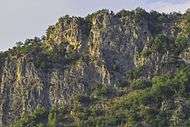 Cliffs above Afurja, near Quba
Cliffs above Afurja, near Quba Mountain road in Gechresh
Mountain road in Gechresh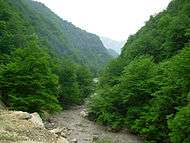 River in Gechresh
River in Gechresh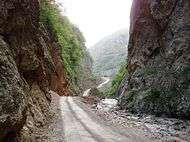 Road to the village of Khinaliq
Road to the village of Khinaliq- Mountains in Khinalug
- Jek people, 20 August 2012.
References
- Äliyev, redaksiya heyätinin sädri, Ilham Heydär oğlu (2007). Azärbaycan : Azärbaycan milli ensiklopediyası. Bakı: "Azärbaycan Milli Ensiklopediyası" Elmi märkäzi. ISBN 9789952441017.
- "Əhalisi". Quba Rayon İcra Hakimi. Retrieved 11 November 2015.
- "Şəhərlərarası telefon kodları". Aztelekom MMC. Aztelekom İB. Retrieved 19 August 2015. (in Azerbaijani)
- "The data on regions -> Agricultural yield: Apple orchards – total area".
- "Desa Mungil di Azerbaijan Ini Dipenuhi Kebun Hijau - Uzone". Retrieved 2018-08-11.
- "Population statistics of Eastern Europe: Ethnic composition of Azerbaijan by 1999 census".
- "Population statistics of Eastern Europe: Ethnic composition of Azerbaijan by 1999 census".
- "Population statistics of Eastern Europe: Ethnic composition of Azerbaijan by 1999 census".
- "Political division, population size and structure: Population by towns and regions of the Republic of Azerbaijan".
- "Healhcare of Quba".
- "Quba - Xaçmaz iqtisadi rayonu - Quba rayonu".
- "Education of Quba".
| Wikimedia Commons has media related to Quba Rayon. |